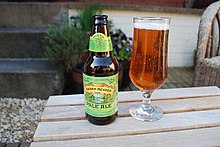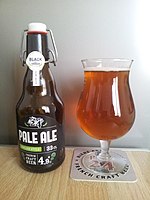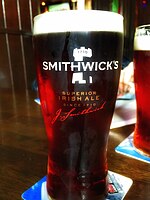Pale ale

Pale ale is a golden to amber coloured
History
By 1830, the expressions bitter and pale ale were synonymous. Breweries tended to designate beers as "pale ales", though customers would commonly refer to the same beers as "bitters". It is thought that customers used the term bitter to differentiate these pale ales from other less noticeably hopped beers such as porters and milds.
By the mid to late 20th century, while brewers were still labeling bottled beers as pale ales, they had begun identifying cask beers as "bitters", except those from
Types
Different brewing practices and hop levels have resulted in a range of taste and strength within the pale ale family.[5]
Amber ale

Collier Brothers of London applied for the UK trademark of The Amber Ale in 1876 and the trademark was maintained through changes in ownership until it expired as UK00000009744 in 2002.
Amber ale is an emerging term used in Australia, France (as ambrée), Belgium and the Netherlands and North America for pale ales brewed with a proportion of
American pale ale

Anchor Liberty Ale, a 6% abv ale originally brewed by the
The brewery thought to be the first to successfully use significant quantities of American hops in the notably hoppy style of an APA and use the specific name "pale ale" was the Sierra Nevada Brewing Company.[15] It brewed the first experimental batch of Sierra Nevada Pale Ale in November 1980,[16] distributing the finished version in March 1981.[17] Other pioneers of a hoppy American pale ale are Jack McAuliffe of the New Albion Brewing Company and Bert Grant of Yakima Brewing.[18][19]
American pale ales are generally around 5% abv, with significant quantities of American hops, typically Cascade.
Bière de garde

Bière de garde, or "keeping beer", is a pale ale traditionally brewed in the Nord-Pas-de-Calais region of France. These beers were usually brewed by farmhouses in the winter and spring, to avoid unpredictable problems with the yeast during the summertime.
The origin of the name lies in the tradition that it was matured or cellared for a period of time once bottled (most were sealed with a cork), to be consumed later in the year, akin to a
Among the better French known "bières de garde" are Brasserie de Saint-Sylvestre, Trois Monts, Brasseurs Duyck, Jenlain and Brasserie La Choulette, ambrée.
Blonde
Blonde ales are very pale in colour. The term "blonde" for pale beers is common in Europe and South America – particularly in France, Italy, Belgium, the Netherlands, the UK, and Brazil – though the beers may not have much in common, other than colour. Blondes tend to be clear, crisp, and dry, with low-to-medium bitterness and aroma from hops, and some sweetness from malt. Fruitiness from esters may be perceived. A lighter body from higher carbonation may be noticed.
In the United Kingdom, golden or summer ales were developed in the late 20th century by breweries to compete with the pale lager market. A typical golden ale has an appearance and profile similar to that of a pale lager. Malt character is subdued and the hop profile ranges from spicy to citrus; common hops include Styrian Golding and Cascade. Alcohol is in the 4% to 5% abv range. The UK style is attributed to John Gilbert, owner of Hop Back Brewery, who developed "Summer Lightning" in 1989, which won several awards and inspired numerous imitators.[26]
Burton pale ale
Late in the second half of the nineteenth century, the recipe for pale ale was put into use by the
English bitter

The expression English bitter first appeared in the early 19th century as part of the development and spread of pale ale.[31] Breweries tended to designate beers as "pale ales", though customers would commonly refer to the same beers as "bitters". It is thought that customers used the term bitter to differentiate these pale ales from other less noticeably hopped beers. Drinkers tend to loosely group modern bitters into "session" or "ordinary" bitters (up to 4.1% abv), "best" or "special" bitters (between 4.2% and 4.7% abv) and "strong" bitters (4.8% abv and over).[citation needed]
India pale ale (IPA)
India pale ale (IPA) is a style of pale ale developed in England for export to India. The first known use of the expression "India pale ale" is in an advertisement in the Sydney Gazette and New South Wales Advertiser on 27 August 1829.[32]
The colour of an IPA can vary from a light gold to a reddish amber.
Irish red ale

The term "Irish red ale" was popularised in the United States and subsequently exported worldwide. The additional variants "red ale", "Irish ale" (
are typical examples of macro-brewed commercial Irish red ale. There are many other smaller and craft examples, such as O'Hara's, Sullivan's, Murphy's, Porterhouse and Franciscan Well.Irish red ales are characterised by their malt profile and typically have a sweet, caramel or toffee-like taste, low bitterness and amber to red colour - hence the name.[34]
Irish brewers have increasingly adopted the term Irish Red Ale to distinguish their beers in both the domestic and international markets. In the US, the name can also be used simply to describe a darker amber ale, or the abbreviated term "Irish Red" applied to a "reddish" beer brewed as a lager and ambered with caramel colouring - for example Killian's Irish Red.
Strong pale ale
Strong pale ales are ales made predominantly with pale malts and have an alcohol strength that may start around 5%, though typically at 7 or 8% by volume, and may go up to 12%, though some brewers have been pushing the alcohol strength higher to produce novelty beers. In 1994, the
Beer Festivals and Pale Ales
Beer festivals provide a platform for showcasing a diverse range of Pale Ales from around the world, including both traditional English and American varieties. These events offer visitors the opportunity to taste and compare different styles of Pale Ales, while also promoting craft breweries and encouraging experimentation with new Pale Ale recipes.[36] According to an article on the Beer Council website, regional variations of Pale Ales have gained popularity, with English beers focusing more on malt-forward flavors and American versions showcasing bolder hoppiness from US hop varieties, such as citrus and pine notes.[37]
References
- ^ "Roger Protz on India Pale ale". www.beer-pages.com. Archived from the original on 8 June 2016. Retrieved 3 October 2010.
- ISSN 0004-6701. Retrieved 3 October 2010.
- ISBN 978-0-8342-1684-6. Retrieved 3 October 2010.
- ISBN 978-1-938469-02-2.
- ^ India Pale Ale Archived 8 June 2016 at the Wayback Machine, Roger Protz, beer-pages.com
- ^ "Trade mark number UK00000009744". UK Intellectual Property Office.
- ^ "Collier Brothers advert". Tottenham and Edmonton Weekly Herald. The British Newspaper Archive. 24 May 1879. p. 8.
- ^ James Squire Amber Ale Archived 3 March 2016 at the Wayback Machine - Michael Jackson 1 October 2001: "The designation Amber Ale is to be taken seriously".
- ^ "CraftBeer.com - American Ales". craftbeer.com. 29 July 2012. Archived from the original on 29 July 2012.
- ^ "Duyck Jenlain Ambrée". ratebeer.com. 2011. Retrieved 11 August 2011.
Jenlain Ambrée
- ^ "Styles of Beer". themonk.com.au. 28 September 2023.
- ^ "Ale Styles Guide - IPA & Ale Beer Styles | Beer of the Month Club". The Microbrewed Beer of the Month Club. Retrieved 24 June 2018.
- ^ ISBN 9780762402014. Retrieved 8 July 2011.
- ISBN 9781603420891. Retrieved 8 July 2011.
- ISBN 9781118061879. Retrieved 8 July 2011.
- ^ "Sierra Nevada Our Story". sierranevada.com. 2009. Retrieved 8 July 2011.
- ISBN 9780156033596. Retrieved 8 July 2011.
- ^ John Holl (2011). "CraftBeer.com | Featured Brewery: New Albion Brewing". craftbeer.com. Archived from the original on 24 June 2010. Retrieved 8 July 2011.
- ^ Michael Jackson (2011). "Michael Jackson's Beer Hunter - How Bert Grant Saved The World". beerhunter.com. Retrieved 8 July 2011.
- ^ "CraftBeer.com | American Ales". craftbeer.com. 2011. Archived from the original on 29 July 2012. Retrieved 8 July 2011.
- ]
- ISSN 0362-4331. Retrieved 8 July 2011.
- ISBN 9780762441600. Retrieved 8 July 2011.
- ]
- ISBN 9780470374160. Retrieved 8 July 2011.
- ^ "Hop Back Summer Lightning « Beer Culture with Des de Moor". desdemoor.co.uk. Retrieved 5 June 2010.
- ^ Tim Webb. Good Beer Guide to Belgium, 6th edition, p 81.
- ^ The Complete Handbook of Beers and Brewing Brian Glover
- ^ Miller, John W. "Belgium's Duvel Finds Crafty Success". WSJ.
- ^ Simmonds, Peter Lund (1858). The dictionary of trade products ... - Google Books. Retrieved 3 October 2010.
- ^ "Bitter, Ordinary and Special". All About Beer - Beer News, Reviews, Events, and Education. November 2004. Retrieved 12 January 2020.
- The Sydney Gazette and New South Wales Advertiser (NSW : 1803 - 1842). NSW: National Library of Australia. 27 August 1829. p. 3. Retrieved 17 August 2013.
- ^ "BeerTools.com Recipe Library - Leann Dearg". www.beertools.com.
- ^ "Irish-style Red Beer". craftbeer.com. Retrieved 1 October 2021.
- ^ "Hair of the Dog Dave from Hair of the Dog Brewing Company, a Barley Wine style beer: An unofficial page for Hair of the Dog Dave from Hair of the Dog Brewing Company in Portland, Oregon , United States of America". Ratebeer.com. 26 September 2013. Retrieved 12 August 2014.
- ^ "Getting To Know The Pale Ale: From English Origins To American Variations". Beer Council. Retrieved 20 April 2023.
- ^ "Getting To Know The Pale Ale: From English Origins To American Variations". Beer Council. Retrieved 20 April 2023.
Bibliography
- Farmhouse Ales: Culture and Craftsmanship in the European Tradition, Phil Markowski, ISBN 0-937381-84-5
- Great Beer Guide: 500 Classic Brews, Michael Jackson, ISBN 0-7513-0813-7
- Dictionary of Beer, Ed: A. Webb, ISBN 1-85249-158-2
